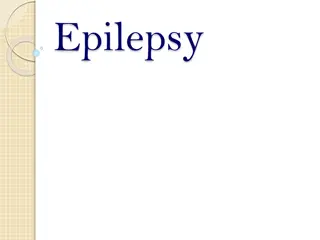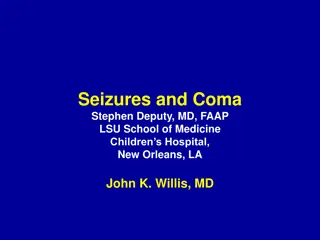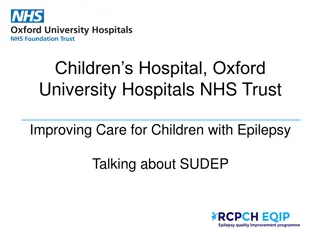Establishing Transition Service for Young Epilepsy Patients at Aneurin Bevan University Health Board
The RCPCH Epilepsy Quality Improvement Programme at Aneurin Bevan University Health Board aimed to improve the transition process for young epilepsy patients. The project team implemented the Ready, Steady, Go model to educate teenagers about managing their condition independently. Changes included setting up transition clinics, using innovative communication methods, and managing expectations regarding adult epilepsy services. The team piloted virtual video transition clinics for enhanced accessibility. These efforts aimed to better prepare patients and families for the transition to adult neurology services.
Download Presentation

Please find below an Image/Link to download the presentation.
The content on the website is provided AS IS for your information and personal use only. It may not be sold, licensed, or shared on other websites without obtaining consent from the author.If you encounter any issues during the download, it is possible that the publisher has removed the file from their server.
You are allowed to download the files provided on this website for personal or commercial use, subject to the condition that they are used lawfully. All files are the property of their respective owners.
The content on the website is provided AS IS for your information and personal use only. It may not be sold, licensed, or shared on other websites without obtaining consent from the author.
E N D
Presentation Transcript
RCPCH Epilepsy Quality Improvement Programme November 2019 July 2020 Establishing a Transition service Aneurin Bevan University Health Board RCPCH Epilepsy Quality Improvement Programme project team: Dr M. Barber, Consultant Paediatrician J. Barber, Children s Epilepsy Nurse Specialist K. Spender, Children s Epilepsy Nurse Specialist Dr J. Anderson, Consultant Neurologist J. Edwards, Children s Epilepsy Nurse Specialist L. Capeling, Children s Epilepsy Nurse Specialist A. Johnson, Consultant Paediatric Clinical Psychologist Dr Charlotte Lawthom, Consultant Neurologist Dr Demetria Demetriou, Specialist Trainee, National audit results included within this case study acts as a guide only to performance standards. The service improvements made during the EQIP cannot be entirely attributed to the reported results in the Epilepsy12.
Transition pathways - Aneurin Bevan University Health Board Project aim 90% of all 14 16-year-old young with epilepsy will have been sent Ready, Steady, Go forms to incrementally educate teenagers regarding their condition and help them develop the necessary skills required for managing their epilepsy independently as young adults by May 2020.. Background: Prior to March 2020, paediatric patients with a diagnosis of epilepsy approaching the transition stage from paediatric services to adult neurology were only offered one joint handover clinic." The patients and their families had little or no preparation at all for this transition. Likewise, there was little preparation by clinicians for the issues to be discussed. An urgent need for facilitating this and improving the transition of patients to adult neurology services was identified by both teams. Area of focus The widely known and nationally used transition model Ready, Steady, Go developed by the Southampton Children s Hospital was chosen to be tested with patients. This model uses three sets of questions designed for young people at different stages in their development or 'readiness for transition. Proving a guide for discussion at appointments and agenda setting for the next appointment.
Transition pathways - Aneurin Bevan University Health Board Additionally, the team planned to manage expectations for how the adult epilepsy service functions, help patients engage with the adult health care team, and answer any remaining questions regarding the diagnosis, medications, or prognosis of their condition. Changes Established how patients and families would like to receive information about their healthcare, i.e., via surveys, in- person appointments, using engagement methods such as pasta voting. Dissemination of the Ready, Steady, Go questionnaires to patients of transition age by post to help build the teams experience of using the forms while exploring email and internet link text delivery methods. Submitted questionnaires were collected during clinic appointments, including basic contact details from patients and their families. Set-up of clinic space and availability for a joint consultant-led epilepsy transition clinic and a joint nurse-led clinic to occur simultaneously alongside the consultant clinic. The team utilised the Health Board s introduction of the AttendAnywhere video consultation software to pilot a virtual video transition clinic with clinicians (in separate locations) and patient/carers. This was used with a limited number of patients due to the newly implemented software.
Transition pathways - Aneurin Bevan University Health Board Results The engagement method of pasta voting, which began in December 2019, was successful and captured feedback from patients and families on their preferences for how they would like to receive information regarding their healthcare via electronic means of email or text. However, at the time, the team was unable to do this reliably and had to seek help and advice from internal IT services. Pasta voting Results Clear Winner EMAIL OR TEXT. Face-to-face: 17 votes; post: 28 votes; email or text: 56 votes. While there was a preference for email or text message to share the online questionnaires, the spread of preferences shown in the pasta voting clearly demonstrated the need to maintain flexibility to be able to offer any mode of sending the forms to patients. This includes post, email, electronic online completion, and completion only in person at in-person appointments. appointments. From the 197 patients identified, 194 had received the Ready, Steady, Go transition questionnaire.
Transition pathways - Aneurin Bevan University Health Board Pasta Voting Results Clear Winner EMAIL OR TEXT. Face to face 17 votes, Post 28 votes, Email or text 56 votes. Pasta voting Results Email/Text Face-to-face Post 28% 55% 17% Established how patients and families would like to receive information about their healthcare i.e. surveys and appointments, using pasta voting.
Transition - Aneurin Bevan University Health Board Example of a transition questionnaire for patients with complex needs Transition Programme for Children with Complex Needs We want to support you and your family as you grow up and transition into adult care. Name: Date of Birth: Hospital Number: Named Nurse: Review one: Ready Review Two: Steady Review 3: Go (please circle) Knowledge and skills Yes No I would like extra advice or help Comments of Young Person/ Parent/Carer Comments from CENS Does the child/family have a good understanding of the child s condition? Do they know medications, names, doses, how often, reordering medication? Do they know who is who in the medical team? Do they understand the differences between paediatric and adult healthcare?
Transition pathways - Aneurin Bevan University Health Board Example of feedback form shared with patients and families on using questionnaire.
Transition pathways - Aneurin Bevan University Health Board Ready, Steady, Go transition model Review One: Ready READY Start Transition Process when the child reaches 11-12 years old Start Transition Process when the child reaches 14 years old Add to EPTRAN Watchlist Send out Red Ready Paperwork and meet with the child/family to discuss in CENS clinic Discuss relevant Paperwork with family/ young person in CENS clinic Add to EPTRAN Watchlist Upload Paperwork to CWS Upload Paperwork to CWS Complete eForm Complete eForm Review Two: Steady STEADY When the child reaches 13-15 years old send out Amber Steady Paperwork When the child reaches 16 years old Complete Review two Meet young person/family in CENS clinic to discuss Discuss relevant Paperwork with family/young person in CENS clinic to discuss Update Watchlist Update Watchlist Upload Paperwork Upload Paperwork Complete eForm Review Three: Go Complete eForm GO When the child reaches the age of 18 complete Review three When the child reaches the age of 15-16 send out Go Green Paperwork Update Watchlist Upload Paperwork Discuss Paperwork with family/young person Meet young person in clinic with family to discuss Update Watchlist Triage patient for CENS/AENS Clinic or Upload Paperwork Is the LD Team involved? Joint Consultant Clinic and Book in on Word Document Triage patient for CENS/AENS Clinic or Have the family got an adult social worker? Joint Consultant Clinic and book in on Word Document Complete eForm Complete eForm Transfer Patient to Adult Services READY FOR ADULT SERVICES Patient should Transfer across to adult services at the age of 19. Patient should Transfer across to adult services at the age of 16.
Transition pathways - Aneurin Bevan University Health Board From all the 197 patients identified, 194 have received the Ready, Steady, Go transition questionnaire. % of patients received the initial transition document 2% Received Remaining 98%
Audit results cohort 3 -Transition referral pathway- Aneurin Bevan University Health Board In 2021, Aneurin Bevan University Health Board re-established an agreed referral pathways to adult services for their children and young people with epilepsy. Transition questions 2019 2020 2021 Does your Health Board or Trust have agreed referral pathways to adult services? Yes - Yes Does your Health Board or Trust have an outpatient clinic specifically for 'young people' with epilepsies? No - No Does your Health Board or Trust have an outpatient service for epilepsy where there is a presence of both adult and paediatric professionals? Yes - Yes - If yes does this comprise of : A single joint appointment Yes - Yes Which adult professionals are routinely involved in transition or transfer to adult services? Adult epilepsy specialist nurse Yes - Yes Adult learning difficulty Yes - Yes Adult neurologist Yes - Yes Youth worker No - No Other No - No Does your paediatric service use structured resources to support transition (e.g. Ready Steady Go)? Yes Yes
Transition pathways - Aneurin Bevan University Health Board Challenges The impact of the COVID-19 pandemic on the service was immense. The plans to commence adjacent consultant- led and nurse-led transition clinics were hindered by the pandemic. Time pressures meant the children s epilepsy nurses completed only the final green phase of the Go form of the Ready, Steady, Go questionnaires with patients. The team experienced difficulty obtaining completed forms of the Ready, Steady, Go questionnaire. The only method that seemed to work with patients completing their questionnaires was if they filled them out over the phone or in clinic. Developing an electronic delivery method for questionnaires, including the collection of phone numbers and email addresses, to gain feedback on the process was challenging. Finding an optimal way to maintain the watch list of all transition patients to track and send transition forms and receive completed forms when a patient reaches transition age was difficult and relied on ESNs confirming and checking the watch list. Ascertaining a successful return rate for the Ready, Steady, Go forms.
Transition pathways - Aneurin Bevan University Health Board Outcomes Achieved 90% of all young people aged 14 16 years, with epilepsy being sent the initial transition questionnaire by May 2020, managed to achieve 98%. Increased patient engagement using tools and techniques learned by the CYP engagement team training on the EQIP. Achieved closer teamwork with colleagues. The set-up of transition clinics as planned a nurse-led clinic and a consultant-led clinic running side by side in the same outpatient department occurred temporarily (pre-pandemic). Each clinic had its own waiting list. These clinics worked well and will be revisited and planned to run on a Friday afternoon every 2 months starting April 2020. National audit results showed that in 2021 Aneurin Bevan University Health Board re-established an agreed referral pathways to adult services for their children and young people with epilepsy. Re-established single joint appointments with adult professionals: Adult epilepsy specialist nurse, Adult neurologist and Adult learning difficulty who are routinely involved in transition or transfer to adult services.
Transition pathways - Aneurin Bevan University Health Board Lessons learnt The team found the pace of change in service delivery and the testing of new ways of working exciting and invigorating. The team agreed to pause and undertake a detailed review of the work during this time to see what can be taken forward and implemented more permanently in the service. There is a potential to give young people and families more choice in the methods of interaction and advice and encourage more active engagement with children and young people. The team would encourage others to try out different ways of service delivery and methods of interaction with their patients and families to test, evaluate, and re-evaluate the outcomes. Keeping young people and their families central is key to effective engagement and shaping the epilepsy service that works for them in the future. Clinical nurse specialists are integral to service development and inter-disciplinary teamwork, with the sharing and development of roles within the team.
Transition pathways - Aneurin Bevan University Health Board Lessons learnt Transition of young epilepsy patients will always be a challenge, tailoring services to their very individual needs and addressing co-morbidity and how that impacts the transition. However, Epilepsy12 has been energising in the team s endeavours to improve experiences for young people, as has the COVID-19 impact in shaping their use of technology, affording choice, and new ways of service delivery. Visual presentation of team project intervention Team Poster PDF
https://eqip.rcpch.ac.uk eqip@rcpch.ac.uk @RCPCHEQIP























